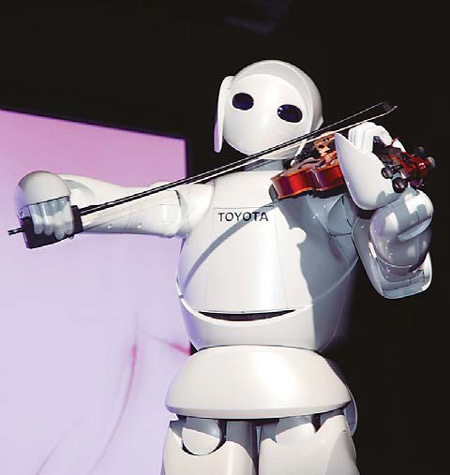|

Robotics on display in Japan Pavilion is in response to the problems of an ageing population in the country. Yong Kai / China Daily |
Innovative ways of coping and caring for ageing populations are highlighted at two country pavilions, Yu Ran reports.
To fit in with the Expo theme of Better City, Better Life as a means to a future with an improved urban environment, the Japan and German pavilions in the Expo Garden are exhibiting ideas on how to resolve a global predicament - ageing populations.
The Japan Pavilion is keen to showcase the nurturing connection between technology and people, especially the elderly.
"The shift in the distribution of a country's population towards older ages is something all countries will face sooner or later, including Japan," said Hiroshi Tsukamoto, the commissioner-general of the Japan Pavilion. "Therefore, we decided to add the subject of population ageing to the exhibition as a challenge we have to face and conquer."
As one of Japan's most famous technologies, much of the robotics on display in its pavilion is a response to the ageing population situation in the country.
A new style of robotics, called the "Partner Robot", designed by Toyota Motor Corporation, catches most attention from visitors. The Partner Robot, with a humanoid form and ability to walk on two legs, is able to assist older people by doing household chores and providing nursing and medical care. The joints of the hands and arms are coordinated by a sophisticated control mechanism, allowing delicate, human-like movements.
"In order to demonstrate that the Partner Robot has humanlike finger dexterity, it plays the violin while fingering the strings accurately," said Tsukamoto. "In the near future, a series of Partner Robots will be manufactured to solve the shortage of labor and help with population ageing services."
During a robot presentation at the Japan Pavilion at the beginning of Expo 2010, visitors were introduced to another robot, designed to do cleaning for the elderly.
Tsukamoto said that more high-technology products and services would be launched by Japanese companies to help the older generation lead a safe, enjoyable and relaxing life.
In the Germany Pavilion, a sample Multi-generation Center is introduced. The center helps provide solutions to the problems of an ageing population by bringing together and integrating different generations of citizens.
The model is an example of a Multi-generation Center in Stuttgart that showcases a new way of strengthening societal cohesion by gathering people from different generations for social occasions and leisure activities.
"Multi-generation Center projects have been carried out in Germany by creating places for senior citizens, younger people and children to gather," said Marion Conrady, press officer with German Pavilion.
In Germany, like many countries in the West, the aging of the country's population is an ongoing problem. In 2005, the number of people 65 years old and over was about 15.9 million. The number was expected to reach 23 million 2050.
Launched in November 2006 by the Ministry of Family Affairs, Senior Citizens, Women and Youth, the Multi-generation Centers aim to break traditional family boundaries and provide opportunities for different generations to communicate.
The centers are financially supported by the government and run by local communities with volunteer services.
Currently, there are over 500 Multi-generation Centers operating, with 16,000 staff, of which two-thirds are volunteers.
"In the centers, the elderly are the major beneficiaries, as the interaction with younger people helps with loneliness and the onset of dementia. It is also good for younger people who can learn much from the older generation," said Conrady.
Conrady said up to one-third of the elderly at these centers saw it as a way to do volunteer work.
She said that German people believe that Multi-generation Centers benefits both older and younger generations, while helping to solve problems faced by elderly citizens.
"Hopefully the elderly can learn from the young generation to lead a healthy and passionate life and the young people may mirror the experiences from the elderly to have a successful future. That's what these centers are for," said Conrady.
(China Daily 08/13/2010)

